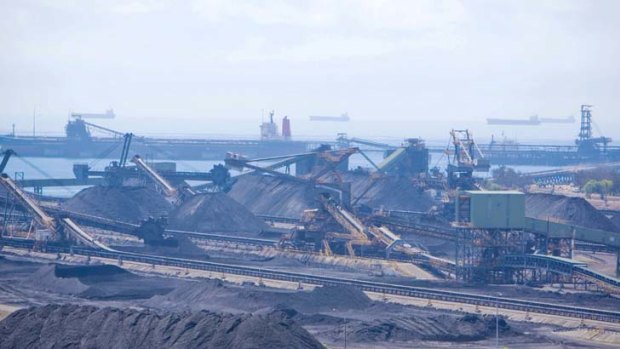Australia is set for an $112 billion infrastructure boom as the nation adds ports and railways to feed China and India's appetite for coal and iron ore.
The largest exporter of the key steelmaking materials will build enough railroads to easily cover the distance from Sydney to Perth over the next decade, as well as a new port on the Great Barrier Reef coast that will dwarf the world's biggest bulk harbour. The projects will near-double global coal trade and add 57 per cent to the market for seaborne iron ore.

Australia's mining boom is drawing in foreign suppliers facing weak markets in their home economies.Credit: Glenn Hunt
“There is so much opportunity here,” said Philippe Bouquet, Australia construction head at French builder Bouygues. “People in Paris are very impressed. They say: '23 million people? How can they do so much?'.”
Leighton Holdings, Australia's biggest builder, Bechtel Group and trainmaker General Electric are among companies winning deals as Australia adds transport links to support $232 billion of mineral and energy projects. The demand, coupled with economic slowdowns in the US and Europe, has helped make Australia the developed world's fastest-growing construction market.
“This isn't a short-term phenomenon,” said Hamish Tyrwhitt, chief executive of Leighton. “This is about the urbanisation of India and China and the economic prosperity of the region.”
Ports, rail
Australia's $112 billion plans include building port terminals with capacity of almost 1.5 billion metric tonnes a year by 2022, and laying as much as 3700 kilometres of rail track, according to data compiled by Bloomberg.
One of the main sites is Abbot Point, a small coal port sandwiched between a salt marsh and a lagoon of the Great Barrier Reef. Queensland's state government wants to boost capacity 26-fold from 15 million metric tonne to 385 million tonnes under a construction plan due to begin in 2014. That would surpass by almost 40 per cent the 2011 volumes at China's Qinhuangdao port, the world's biggest dry-bulk harbour.
In the Pilbara iron ore-producing region on the northwest coast, BHP Billiton and Rio Tinto are leading plans to raise ore exports by 538 million tonnes over the next five years. That will more than double output from an area that already accounts for about 40 per cent of the iron ore shipped by sea each year.
Port Hedland, the Pilbara's biggest harbour, plans to add 390 million tonnes of annual capacity by 2016 to support the expansion push. It exported 199 million metric tonnes of cargo in year ended June.
GE trains
GE, which supplies 70 per cent of the locomotives for mines in the Pilbara and Queensland's Bowen Basin coal district, plans to double its total business in Australia by 2014, spokeswoman Joanne Woo said.
This is about the urbanisation of India and China and the economic prosperity of the region
Bouygues, Europe's second-largest listed builder, aims to win two to three new construction deals in Australia each year, Bouquet said. The company has only done three projects in the country since 1995, he said.
Bechtel is building a $US2.5 billion expanded coal port for BHP on the Barrier Reef coast and extending four BHP mines in the Bowen Basin. In Western Australia, Texas-based Fluor is leading the $US3.9 billion expansion of BHP's iron ore terminal at Port Hedland.
“These companies have certainly got expertise that would put them above what would otherwise be available here,” said Phillip Greenham, a construction lawyer at Minter Ellison.
Overseas builders
Still, overseas companies can meet difficulties establishing reliable workforces and setting up supply chains, which may cause them to focus on partnerships with local contractors, according to Steve Gatt, KPMG's Sydney-based lead construction partner.
“There's not a large number of companies that know the geography, the markets and the customers and have a demonstrated ability to build these things,” said Mike Carter, the head of coal-train operator QR National's network division.
The railroad last month completed an $1.1 billion link to Abbot Point. It expects to spend $1.6 billion on its network this year.
Australia spent $176.5 billion on construction in the 12 months to September 2011. Spending has surged 50 per cent since June 2006, giving it the fastest-growing building market of any advanced economy.
New construction spending in the US totalled $US724.8 billion in the 11 months ended November, the lowest level since the 1990s and down 34 per cent from its peak in 2006. An index tracking construction in the European Union was 21 per cent lower in October than in December 2006.
Metal, train imports
The Australian boom is showing up in customs data. The value of large metal sections, used in construction, imported in the 12 months ended November was almost twice the amount for the whole of the 1990s, government data shows.
Rolling-stock imports were a third above the 1990s total. Imports of prefabricated buildings - mainly used for accommodation at remote building and mining projects - almost matched the 1990s total in September alone.
“You are seeing exponential growth,” said Jay Leary, a construction partner with Freehills lawyers in Brisbane. “The projects that are committed and planned for the next few years are game-changing.”